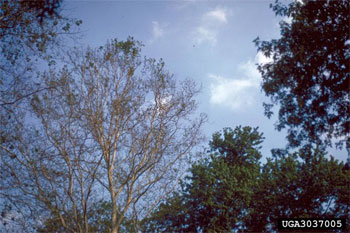Sycamore Anthracnose
Natural History

Sycamore anthracnose defoliation | Photo credit: Bugwood.org
Sycamore anthracnose is a disease caused by the fungus Apiognomonia veneta. Anthracnose is a general term that refers to necrosis or dead patches that occur on leaves, and sometimes buds and stems of numerous hardwood species. Sycamore anthracnose affects buds, twigs, shoots, and leaves of trees in the genus Platanus. These trees are commonly called sycamores or plane trees.
In early spring, twigs and buds that are infected by spores produced by the fungus that has overwintered in leaf and stem litter die before leaves emerge. Small black fruiting bodies often form on killed tissues and new infections take place on developing shoots. These developing shoots and new leaves often die suddenly as a result. Later in the summer, secondary infections take place on both new and old leaves.
Cool, moist weather in March and April favors the development of the disease. Severely affected trees may be defoliated prematurely and cankers on stems can cause significant dieback.
